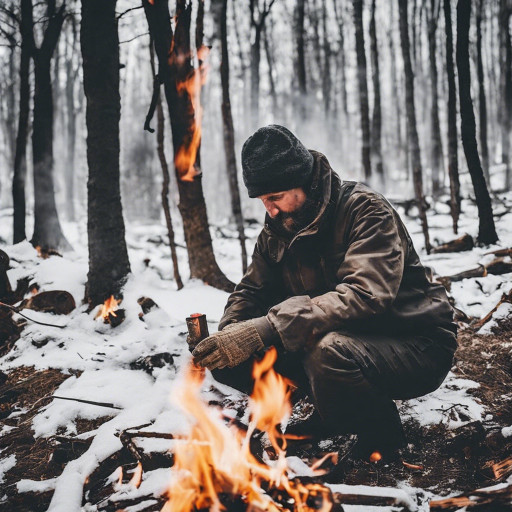Master Proven Techniques for Safely Starting Fires in Freezing Temperatures
Starting a fire in frigid conditions is not merely a skill; it is an essential survival tactic when faced with the harsh realities of winter, characterized by biting cold and relentless winds. As an enthusiastic survivalist, you recognize the critical importance of fire for maintaining body warmth, providing light for navigation, and enabling food preparation in the wilderness. However, the unique challenges that icy environments present demand specific techniques and strategies tailored to overcome these obstacles. In this comprehensive guide, we will delve into the most effective methods for successfully igniting flames during extreme cold, equipping you with invaluable knowledge and skills to conquer winter’s harsh grip and thrive in the great outdoors.
Essential Gear for Successful Fire Starting in Cold Weather
Before you set out on your winter wilderness adventures, it’s imperative to arm yourself with the right gear and supplies that can greatly enhance your survival prospects. A well-organized fire-starting kit can be a game-changer when facing adverse weather conditions. Ensure your kit includes the following critical items:

a. Firestarters: Dependable tools such as waterproof matches, storm-resistant lighters, and fire-starting rods are crucial to ensuring ignition, even amidst challenging factors like wind and moisture. Carrying multiple options will boost your confidence in your ability to start a fire, no matter the environmental hurdles you encounter.
b. Dry Tinder: Finding dry tinder in the depths of winter can be a formidable task. To counter this challenge, pack highly flammable materials like birch bark, fatwood shavings, and cotton balls infused with petroleum jelly. These materials ignite quickly and significantly improve your chances of successfully starting a fire when temperatures plummet below freezing, ensuring you remain warm and secure.
c. Kindling: To create a strong base for your fire, gather an assortment of dry sticks, twigs, and leaves. It’s critical that these materials are completely dry; any moisture present can hinder the ignition process and lead to frustration when trying to spark a flame. Well-prepared kindling is essential for transitioning from tinder to a more robust fire that can withstand the elements.
d. Fuel: Obtaining dry firewood in cold conditions can be both exhausting and time-consuming. Therefore, having a sufficient supply of seasoned firewood ready in advance is vital for maintaining a steady blaze over an extended period, allowing you to stay warm and prepare meals comfortably without interruption.
Strategically Choose the Perfect Location for Your Fire
When facing freezing temperatures, selecting the right location for your fire can provide considerable benefits. Look for sheltered spots, such as rock formations or dense thickets, to minimize exposure to harsh winds. By positioning your fire near a natural windbreak, you not only mitigate heat loss but also enhance the chances of sustaining a steady flame. Additionally, consider building a small wind-resistant shelter using logs or a tarp to protect the fire from rain and snow, thus retaining warmth and improving your overall comfort and safety in the wilderness.
Utilize the Layering Technique for Building Sustainable Fires
One of the most critical techniques for successfully igniting a fire in cold weather is mastering the art of layering your materials effectively. To construct a fire that burns steadily, it is essential to implement three foundational layers: tinder, kindling, and fuel. Here’s a detailed look at each layer and its significance:
a. Tinder: The base layer, tinder, consists of materials that catch fire quickly and easily. Use fine, dry substances such as grass, paper, or the aforementioned birch bark to ensure a robust initial flame. Ample tinder is crucial for achieving successful ignition, especially in cold environments where conditions can be unforgiving.
b. Kindling: This layer includes small sticks and twigs that catch fire with ease and produce sustained heat. Gradually add kindling to your flame, ensuring adequate spacing between pieces to promote airflow and facilitate combustion. This step is vital for transitioning from small flames to a larger, stable fire that can withstand the cold.
c. Fuel: Once a steady flame has been established, gradually introduce larger pieces of firewood. Ensure the wood is dry, as it will burn longer and produce more heat. Increase the size of the wood pieces progressively, allowing the flames to strengthen before adding larger logs. This structured approach to layering your fire ensures a stable and sustainable blaze that can endure harsh conditions.
Effectively layering your fire creates a well-organized setup that allows the flames to expand and sustain themselves efficiently. Always ensure you have an ample supply of each component readily available to facilitate a smooth transition from tinder to fuel, guaranteeing a successful fire in challenging conditions.
Enhance Your Fire-Starting Success with Effective Aids and Techniques
In extremely cold weather, leveraging additional fire-starting aids can significantly improve your chances of successfully igniting a fire despite the challenges posed by low temperatures. Here are some proven methods to consider:
a. Fatwood: Often referred to as nature’s firestarter, fatwood is pine wood infused with resin that ignites easily and burns with intense heat. You can collect these naturally occurring sticks from fallen pine trees or purchase them from outdoor supply retailers. A few pieces of fatwood can drastically enhance your likelihood of successfully starting a fire in exceptionally cold conditions, making it an invaluable addition to your kit.
b. Alcohol-Based Hand Sanitizer: Surprisingly effective, alcohol-based hand sanitizer is highly flammable and acts as an excellent accelerant. A small amount applied to your tinder or kindling can rapidly ignite a fire, even in damp weather conditions, simplifying the fire-starting process and ensuring you remain warm when needed most.
c. Char Cloth: Char cloth is a specially prepared fabric that ignites easily from sparks, making it an exceptional tool for starting fires using flint and steel or a lighter in challenging situations. Its lightweight and portable nature makes it a perfect addition to your fire-starting kit, ensuring you’re always prepared for the unexpected.
Incorporating these fire-starting aids into your cold-weather toolkit can significantly bolster your chances of success when facing particularly challenging conditions, allowing you to adapt effectively to your surroundings.
Explore Effective Fire Techniques Designed for Cold Weather
As a committed survivalist, continuously refining your skills is vital to your overall success. Here are two fire-building techniques that excel in cold weather conditions:
a. Swedish Torch: Also recognized as a Canadian Candle or Finnish Fire Log, the Swedish Torch is an incredibly effective fire-starting method. This technique offers a stable and long-lasting flame, perfect for combating the chill of winter. To create a Swedish Torch, locate a log about knee-height and cut several vertical slits along its length. Place tinder in the slits and ignite it. The log will serve as a consistent fuel source, allowing the flame to endure for an extended period, ensuring warmth and safety during your outdoor adventures.
b. Dakota Fire Hole: When faced with strong winds, the Dakota Fire Hole method proves to be highly effective. This technique involves digging a hole and tunneling horizontally underground to create an airflow vent. This design uses wind to enhance airflow, resulting in a more efficient fire that is less susceptible to disruption by gusts. Furthermore, the Dakota Fire Hole method effectively minimizes visible smoke while conserving fuel, making it an excellent choice for discreet fire building.
Regardless of the technique you choose, always prioritize safety and responsible fire management to minimize risks and ensure a successful fire-starting experience.
Successfully igniting a fire in cold weather demands meticulous planning and execution. By following these steps—preparing a reliable fire-starting kit, selecting an optimal location, mastering layering techniques, utilizing fire-starting aids, and embracing specific fire strategies—you will significantly improve your chances of success. Remember, practice makes perfect, so consistently train to refine your skills and boost your confidence. With these essential tactics for igniting fires in freezing conditions at your disposal, you’ll be well-prepared to face even the harshest winters nature has to offer. Stay warm, prioritize your safety, and keep the flames of survival burning bright!
The post Fire Starting Methods for Survivalists in Cold Weather appeared first on Survival Bite.
The Article Fire Starting Techniques for Cold Weather Survival Was Found On https://limitsofstrategy.com


This guide is a timely reminder of the profound relationship between fire and survival, particularly in winter’s unforgiving embrace. As someone who has spent countless nights camping in the cold, I can attest to the transformative power of a well-tended fire. It’s not just about warmth; it creates a sense of camaraderie and security that can lift spirits in the bleakest conditions.
You’ve captured that essence perfectly. There’s something almost primal about gathering around a fire, isn’t there? It becomes a focal point, not just for warmth, but for sharing stories and forging bonds. I’ve always found that a good fire can bring people together in a way that few other things can. It strips away the distractions and lets you connect on a deeper level, especially during those cold, starry nights.
It’s great to hear your perspective on the role fire plays when camping in winter. There’s something uniquely profound about gathering around a flame in the biting cold, isn’t there? That flickering warmth not only wards off the chill but also sparks connections between people.
This is such an important topic for anyone venturing into the cold! I’ve always found fire-building in winter to be a true test of skill and patience. Last winter, I took a trip to a snowy forest and had to rely on some of these techniques when my lighter fizzled out in the breeze. I remember using dry moss and some birch bark I found, which ignited surprisingly well despite the conditions.
Fire-building in winter really is an art form, isn’t it? Your experience in that snowy forest sounds pretty intense—having to rely on nature for warmth and survival can definitely put you in the zone. Using dry moss and birch bark was a smart move. Those two materials are really underrated in the fire-making hierarchy; it’s great to hear they worked for you even in challenging conditions.
You’ve touched on an experience that a lot of us can relate to when it comes to winter and the challenges of fire-building. It’s interesting how conditions can change our approach to these outdoor skills. Relying on natural tinder like dry moss and birch bark is a smart choice. Birch bark is particularly valuable—not just for its flammability but also because it’s usually found in more exposed areas, so it tends to stay dryer than other materials.
This topic really hits home for me! I remember a particularly freezing camping trip where we struggled to get a fire going. It’s amazing how much the wrong kind of tinder can mess up your plans when you’re up against the cold. I’ve found that packing some dryer lint or cotton balls in my survival kit has made a huge difference. They catch fire so easily, even when everything else feels like ice.
It’s interesting how those chillier camping memories can stick with us, isn’t it? Your experience really highlights the importance of choosing your materials wisely, especially when it comes to fire-making. I can’t agree more about dryer lint and cotton balls; they’re surprisingly effective. I’ve even started bringing some natural fire starters, like fatwood or small twigs, which are great because they can often be found on site.
It’s great to hear your camping story! Those icy trips can definitely test your skills in the wild. Packing dryer lint or cotton balls is such a smart move. They’re like little fire starters in your pocket!
This topic brings back memories of my own winter camping experiences! I can definitely relate to the need for effective fire-starting techniques in freezing conditions. One winter, I found myself battling both the cold and the wind, realizing how critical a fire was not just for warmth but for lifting morale during those long, dark nights.